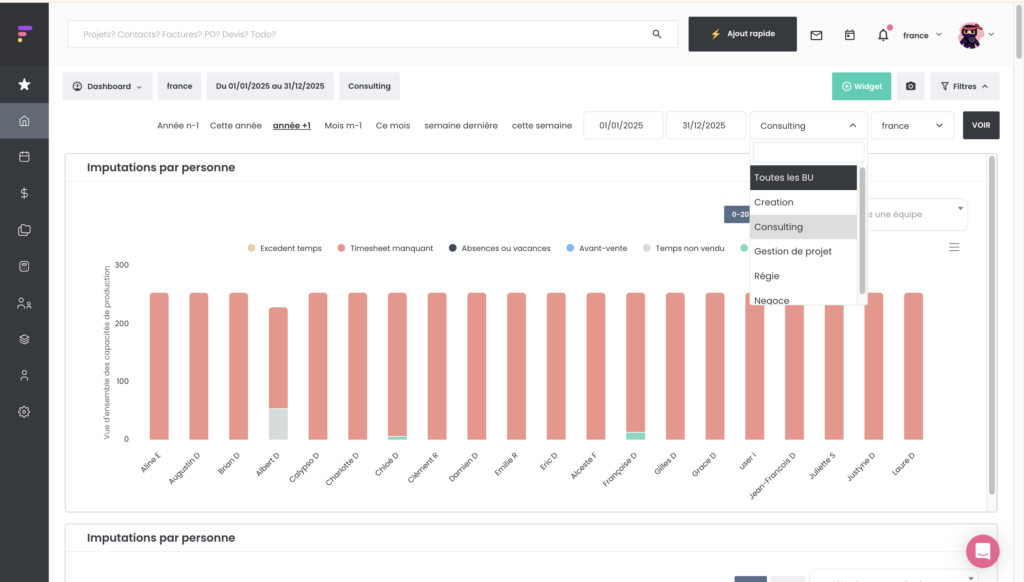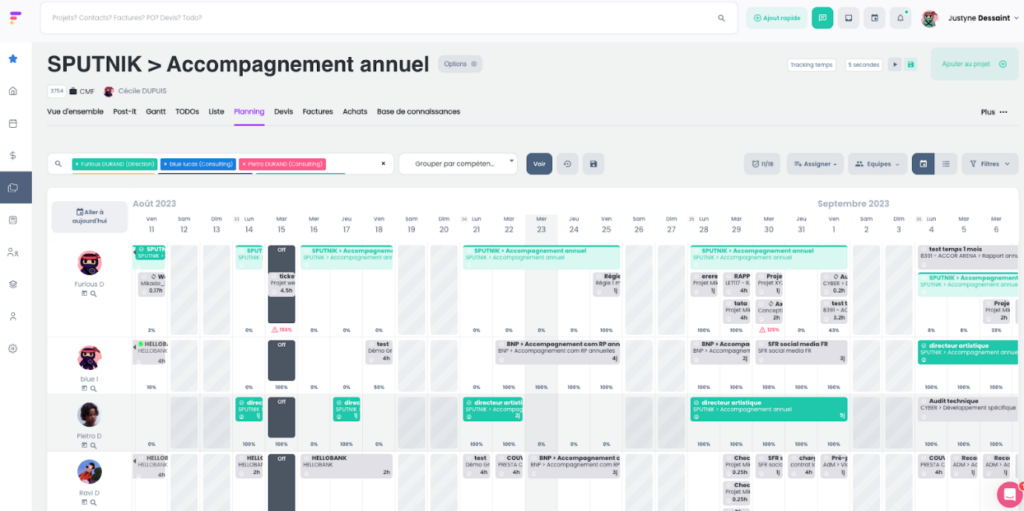In the consulting sector, human resources planning is essential to optimize headcount and achieve an optimal staffing rate, a key performance indicator. In our experience, a staffing rate in excess of 75% for juniors and 80% for management profiles is often a sign of good financial health for a consulting firm. Effective planning enables talent needs to be anticipated, resources to be adjusted in real time, and the organization’s strategic objectives to be aligned. However, many companies find it difficult to maximize the effectiveness of their HR planning due to a lack of suitable tools or insufficient data analysis. Find out how to optimize your HR planning using proven strategies and tools to turn these challenges into opportunities.
Step 1: Understand the Foundations of Human Resource Planning
Define Human Resource Needs
The first step for effective human resource planning is to thoroughly understand your company’s needs in terms of skills and talent. This involves identifying the key positions to fill, the skills required for each role, and the goals to achieve in order to support the organization’s overall strategy. This analysis must be precise and consider future challenges, such as technological advancements, market changes, or new regulations. A solid understanding of human resource needs is the foundation on which any successful HR planning strategy is built.
Analyze Current Human Resources
Once the needs are identified, it is crucial to assess the existing human resources within the organization. This analysis provides an overview of the available skills, identifies gaps relative to the set objectives, and highlights employees whose skills are underutilized or who could be redeployed to meet new challenges. It is also important to understand which teams are struggling and which ones generate the most revenue. This detailed assessment of resources not only enables a more strategic redeployment of staff but also helps in preparing training or recruitment plans to address identified gaps and support the teams that need it most.
Set Clear and Measurable Objectives
Setting clear and measurable objectives is an essential step in human resource planning. These objectives must be aligned with the company’s overall strategy and reflect the organization’s priorities. For example, if the company aims for rapid expansion, HR objectives might include hiring new employees, developing specific skills, or optimizing the performance of existing teams. These objectives should be SMART (Specific, Measurable, Achievable, Realistic, and Time-bound) to enable effective monitoring and real-time adjustments.

Thanks to the features of Furious, you can not only set these objectives but also track them precisely by Business Unit (BU). By using allocations by BU, it becomes possible to measure each unit’s contribution to the overall organization. This allows you to better understand the profitability and performance of different BUs, adjust resources accordingly, and ensure that each unit operates in alignment with the company’s overall objectives. This approach facilitates more granular resource management and ensures that efforts are concentrated where they generate the most value.
L'importance du staffing et de la planification des ressources pour les cabinets de conseil
In a consulting firm, human resource planning takes on a crucial strategic dimension. The success of each project depends not only on technical expertise but also on the ability to align the right people with the right projects at the right time. Staffing is a key lever that directly impacts the firm’s financial performance. Rigorous planning ensures that staff are optimized to maximize revenue while avoiding workloads that could compromise the quality of service.
The challenge, therefore, is to create a strong link between available resources and planning needs, ensuring that each project has the necessary skills for success. At Furious, we understand the importance of these processes for consulting firms. Our tools enable precise resource management and increased visibility on talent allocation, thereby facilitating informed decision-making that supports the success of projects.
Step 2: Use the right tools for effective planning.
Choose a suitable HR software.
One of the key elements in optimizing human resource planning is choosing the right HR software. A well-suited tool should offer several essential features to meet your company’s specific needs:
- Workforce Management: Track staff, skills, and qualifications to ensure each position is filled by the most qualified person.
- Task Planning: Planning tools to manage workloads and allocate resources based on project priorities.
- Process Automation: Automate administrative tasks such as leave management, payroll, and performance evaluations to free up time for higher-value activities.
- Real-Time Data Tracking: Access HR data in real time for informed decision-making and the ability to quickly adjust HR strategies based on organizational needs.
- Compliance and Security: Integrated tools to ensure compliance with current regulations and protect employees’ personal data.
By choosing software that includes these features, you can optimize your HR planning, improve process efficiency, and support your company’s growth.
Automate HR processes
Automating HR processes has become essential for improving efficiency and reducing errors. By automating tasks such as employee data management, leave tracking, or performance evaluations, you free up time to focus on higher-value activities, such as skill development or recruitment strategy. Additionally, automation ensures the quality and consistency of HR processes, making sure that all tasks are carried out uniformly and within deadlines.
Leverage data to make informed decisions
HR data is a goldmine for making informed decisions and anticipating future human resource needs. With a good HR tool, you can collect and analyze a wealth of information on team performance, available skills, time tracking and validation, recruitment, absences and leave, and more.
This analysis allows you to adjust your strategies in real time, optimize workforce management, and plan future business needs more effectively. Strategically leveraging data is crucial for effective HR planning and adapting to market changes.
Incorporate freelancers into human resource planning
The evolving job market has led many companies to include freelancers in their human resource planning. Freelancers provide valuable flexibility to address specific skill needs or manage workload fluctuations. Incorporating freelancers into your HR strategy can be a major asset for enhancing efficiency and optimizing workforce management, while also allowing you to handle busy periods without jeopardizing your long-term cash flow.
— Benefits of freelancers for the company
Freelancers enable companies to access specialized skills without the constraints of long-term commitments. This is especially useful for temporary projects or tasks requiring specific technical expertise not available in-house.
Additionally, freelancers can be quickly mobilized, offering flexibility in resource management according to project needs. However, it’s crucial to closely monitor these external collaborators to ensure they effectively contribute to project goals and integrate smoothly with the team.
— Challenges to address
However, integrating freelancers into HR planning comes with its challenges. It is crucial to ensure that freelancers are well-integrated into the organization and understand the company’s goals and expectations. Effective communication and coordination between freelancers and permanent staff are also essential to maintain productivity, ensure consistent work quality, and foster freelancer retention.
— Best practices for integrating freelancers into HR planning
To maximize the benefits of integrating freelancers, it is recommended to:
- Plan their integration from the start of the project, clearly defining their roles and responsibilities.
- Use collaborative tools to facilitate communication and task tracking.
- Conduct regular performance evaluations to ensure they are effectively contributing to project goals.
- Encourage freelancers to engage in ongoing training to align with company standards and adapt quickly to changing needs.
Strategically integrating freelancers into your HR planning can thus enhance your company’s ability to meet current challenges while optimizing resource use.
Step 3: Optimize workforce and skill management
Plan workforce according to projects and tasks
In a consulting firm, effective workforce planning is crucial for meeting the specific needs of each project and task. It is essential to determine the exact number of staff required for each phase while ensuring that the necessary skills are available internally. The ability to quickly deploy the right resources for critical missions is a key success factor for consulting firms. This also involves being flexible to adjust staffing based on workload variations, such as during peak periods or when new projects are signed.
Proactive workforce management not only ensures project success but also optimizes the firm’s productivity by assigning each employee to tasks where they can deliver the most value. This approach also helps better align resources with the firm’s financial goals by maximizing the use of available skills and minimizing downtime.
Develop internal skills through training
Developing internal skills is another cornerstone of HR planning. Investing in ongoing training for employees not only addresses skill gaps but also prepares the company for future challenges. A well-designed training strategy enhances team performance, promotes talent retention, and boosts employee satisfaction. Training programs should be aligned with the organization’s goals and tailored to meet the specific needs of each team.

Nicolas Quilliet - CEO of Wokine Agency
Furious allows you to track internal employee satisfaction by having them fill out their satisfaction level after each project.
Manage internal mobility to meet strategic needs
Internal mobility is a powerful tool for addressing the company’s strategic needs while optimizing the use of available resources. By encouraging horizontal or vertical moves within the organization, you can not only fill vacant positions but also develop employees’ skills and enhance their engagement. Proactive management of internal mobility strengthens the company’s flexibility and allows for quick adaptation to market changes.
Step 4: Continuously monitor and adjust HR planning
Regularly assess performance
To ensure that HR planning remains aligned with the company’s goals, it is crucial to conduct regular performance assessments. These evaluations help analyze the impact of implemented HR strategies and identify areas that need adjustments. Key performance indicators (KPIs) should be clearly defined from the start to measure the effectiveness of HR processes, such as employee retention rates, turnover rates, and job satisfaction. This data provides valuable insights for real-time adjustments to the strategy.
Adjust the strategy based on the results obtained
Once performance is assessed, it is important to adjust the HR strategy based on the results. This may involve modifying objectives, refining organizational processes, or revising training plans. Constant adjustment of HR planning is essential to respond to market changes and internal shifts within the company. This adjustment process should be quick and efficient to minimize the gap between set goals and actual performance.
Gather employee feedback to improve processes
Employee feedback is crucial for continually improving HR planning. Here are some effective methods to gather this feedback:
- Anonymous surveys: Allow employees to share their opinions confidentially to get honest feedback on HR processes.
- One-on-one interviews: Conduct regular interviews to discuss employees’ experiences, expectations, and daily work challenges.
- Collaborative workshops: Hold group sessions where employees can brainstorm ideas and suggest improvements for planning and task organization.
- Suggestion boxes: Provide physical or digital tools for employees to submit suggestions at any time.
- Real-time feedback: Use instant communication tools to gather immediate feedback during the implementation of new policies or changes in HR processes.
Regularly integrating this feedback into HR planning helps adjust strategies, improve organization, and ensure that employee needs are addressed, enhancing their engagement, productivity, and satisfaction.
Step 5: Anticipate future human resource needs
Identify market trends and their impact on HR
Anticipating future human resource needs requires a deep understanding of market trends and their potential impact on the company. Technological advancements, demographic changes, and regulatory shifts are factors that can influence skill and staffing needs. By staying informed about emerging trends, HR leaders can adapt their planning to meet future demands and maintain organizational effectiveness. Regular strategic monitoring is essential for proactively adjusting HR planning.
Implement a succession strategy for key positions
To ensure operational continuity, it is crucial to develop a succession strategy for key positions within the company. This involves identifying high-potential employees who can be prepared to step into these roles in the future. Succession planning not only enables quick filling of vacant positions but also ensures the organization has the necessary skills to tackle future challenges. A well-thought-out succession strategy also helps improve talent retention by providing clear career development opportunities.
Adopt a proactive approach to talent development
Finally, to anticipate future human resource needs, it is essential to adopt a proactive approach to talent development. This means investing in ongoing training programs, encouraging versatility, and creating professional development opportunities within the company. It is also crucial to continuously align this approach with growing needs, such as considering sales by commercial teams for new projects and clients. Effectively anticipating these changes is key to maintaining a pool of up-to-date skills and ensuring the organization is ready to tackle future challenges. Proactive talent development is a guarantee of long-term resilience and effectiveness for the company.
The benefits of optimized HR planning for your company
Bilancio dei passaggi chiave per massimizzare l'efficacia della pianificazione delle risorse umane
Riassumendo i vari passaggi che abbiamo attraversato, è chiaro che una pianificazione delle risorse umane ben strutturata e ottimizzata può migliorare notevolmente la gestione e l’efficacia della tua azienda. Dalla definizione delle esigenze in termini di competenze all’anticipazione delle sfide future, ogni fase contribuisce a rafforzare la performance complessiva dell’organizzazione. L’uso di strumenti appropriati, l’automazione dei processi e un approccio proattivo allo sviluppo dei talenti sono tutti strumenti che aiutano a raggiungere gli obiettivi prefissati.
Come implementare queste pratiche già da oggi
È il momento per i responsabili delle risorse umane e i decisori di agire. Implementare queste pratiche già da oggi vi permetterà di prendere un vantaggio sui vostri concorrenti e costruire un’organizzazione più resiliente e performante. Non lasciate che la complessità della pianificazione HR vi fermi; al contrario, consideratela come un’opportunità per trasformare la vostra azienda in un attore più agile e competitivo. La chiave è iniziare con una strategia chiara, supportata da strumenti e dati solidi, e adattare continuamente il vostro piano in base ai risultati.
Come Furious vi accompagna nella vostra trasformazione HR
Da Furious Squad, comprendiamo le sfide della pianificazione delle risorse umane in un ambiente aziendale in continua evoluzione. I nostri strumenti di gestione integrata sono progettati per aiutarvi ad automatizzare i vostri processi, ottimizzare i vostri organici e sviluppare le competenze dei vostri collaboratori in modo efficace. Vi accompagniamo in ogni fase della vostra trasformazione HR, fornendovi le soluzioni necessarie per attuare una pianificazione HR che supporti pienamente i vostri obiettivi strategici.
